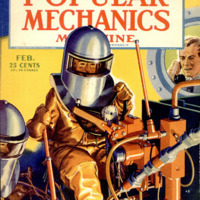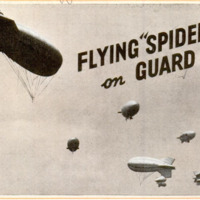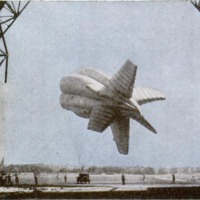SWARMS of great, fat “spiders,” which float high in the air anddangle webs of steel to entangle enemy warplanes, are being assembled rapidly to protect America's defense bases and harbors, factories, the Panama Canal and other vital spots. Already found absolutely indispensable in the defense of critical areas across the Atlantic, these spiders are barrage balloons, some of which can rise to 15,000 feet and ride at anchor, tethered to earth by cables that form a dangerous web. An actual hazard - a collision with a cable usually sends a plane to destruction - the big, hydrogen or helium-inflated bags also create a tremendous mental hazard because they can be moved readily from place to place and the enemy pilot never knows where he will encounter the web. And this fear of striking a cable, particularly at night, forces raiding bombers to fly so high that their accuracy may be affected. Hundreds of the balloons are being constructed and thousands of men are being trained to handle them. Responsibility for instructing U. S. Army officers and enlisted personnel in this specialized work lies with the Coast Artillery Corps. Before completion of the permanent training center, Camp Tyson, near Paris, Tenn., where there are facilities for over 7,000 men, a temporary school was conducted for several months at Camp Davis, N. C., with both officers and enlisted men attending six and 12-week courses and then helping to train others, thus building up a large force to man balloons, trucks, winches and related equipment now coming out of factories in such quantities as to make possible the organization of a large number of battalions. At Camp Davis balloons 28 feet wide and 85 feet long were used. Classified as 27,000 cubic-foot balloons, they were inflated from small cylinders of helium, with each balloon requiring from 115 to 130 cylinders. Only partly trained crews were found capable of inflating a balloon in less than 30 minutes. Since speed is highly essential in getting the bags into the air to ward off raiding planes, great emphasis was placed on reducing inflation time. In use as protectors of military objectives, the balloons are controlled by gasoline-driven winches, either of the mobile type that can be transported from position to position by truck or of the type designed for mounting permanently on a truck. The balloons can be released “up” or hauled “down” at the rate of 1,000 feet per minute, with the winches unwinding or reeling in the cable on a large spool or drum. Three-sixteenths-inch cable was used on the Camp Davis balloons, which were of a type capable of reaching 7,500 feet. When the balloons are not supporting their steel web, they are “bedded down” - pulled to earth by the ground crew and staked down. What is known as the balloon bed is a space large enough to bed down an inflated balloon. Preparation of the bed is accomplished by clearing the ground of all obstacles, covering the space with canvas and digging a drain ditch around the area to carry away rain water. Barrage balloons generally are of two different types, one called ballonet, the other dilatable. Balloons maintain their shape due to the excess of internal pressure over that of the outside atmosphere. This super-pressure must be high enough to prevent the force of the wind velocity from deforming the shape of the balloon. In the ballonet type, the lower portion of the balloon is an air chamber separated from the gas chamber. A wind scoop takes air into the air chamber, causing an internal pressure proportional to the wind velocity. In the dilatable type, rubber shock absorber cords permit the balloon to expand or contract as pressure changes. Pride of the Goodyear Tire and Rubber Company, one of several concerns con- structing the “spiders,” is what the engineers call the “Strato Sentinel,” which has a hydrogen capacity of 68,000 cubic feet, a ceiling of 15,000 feet and a tail from which six finlike lobes protrude. Made of rubberized cotton fabric, it is said to be the highest altitude barrage balloon ever built. Another Goodyear balloon is the D-5, which has a 30,000 cubic-foot capacity, a 7,500-foot ceiling and is made of synthetic rubber cloth of cotton impregnated with black gum that gives it a dark appearance. It has four lobes which are given a fluted appearance by elastic cords. When gas in the fins expands as the balloon rises, the lobes swell into smooth contour. A third balloon, especially designed for the Navy’s use, is a 5,500 cubic-foot bag designed for altitudes of 3,000 to 4,000 feet. Small balloons of this type are useful to the army, also, for preventing enemy strafing of moving columns of troops. They can be transported by trucks, carried beneath bridges and raised speedily to 1,500 feet. Regarding the effectiveness of the balloon barrage, Major General J. A. Green, Chief of the Coast Artillery, says: “Barrage balloons are considered by military authorities as ideal for added protection of the locks of the Panama Canal, the Welland Canal and the Sault Ste. Marie. These are small targets. To be assured of obtaining hits, low flying or dive bombing is necessary. The balloons prevent this. If they are used in sufficient numbers, they force the enemy to fly at such a height that the bombardier’s chance of registering a hit, even if he safely weathers antiaircraft fire, are immeasurably less than they would be were he free to approach close fo the locks before releasing his bombs. As with canal locks, it is the same with other small but vitally important targets - ship anchorages, overseas bases, sources of power supply, rail terminals, important industrial plants, ammunition supply points, bridges and a hundred other types of critical installations that must be defended at any cost. If it becomes necessary, barrage balloons are certain to be used extensively for the defense of our metropolitan and industrial centers. Take, for instance, New York and Boston. To ring them completely with antiaircraft artillery would require a tremendous amount of costly equipment, but to cover certain areas with the less costly balloons and other areas with antiaircraft artillery would simplify the task and still provide a strong defense. During recent months numerous reports from European sources have been carefully studied in the War Department. Some of these reports tell of the number of German aircraft that have come in collision with the British balloon cables. The usual result has been that the plane has crashed or has been forced to land in enemy territory. “We do not know yet all of the situations under which it will be practical to use barrage balloons to advantage. These problems are being studied intensively. One problem that is receiving very careful study relates to the close coordination that must be effected between the employment of the barrage balloon and our own defending aircraft. You can appreciate the importance of such a study, for the balloon cable does not differentiate between friendly and enemy airplanes. Studies are also being made to determine how best to use the balloons with their supporting antiaircraft artillery.”
 Popular Mechanics, vol. 77, n. 2, 1942
Popular Mechanics, vol. 77, n. 2, 1942





